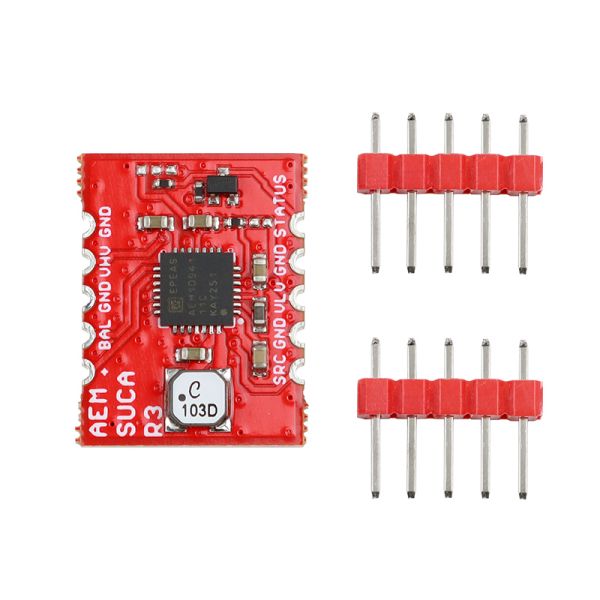Solar Harvesting Into Supercapacitors
- Buy 5 for $16.92 each and save 15%
- Buy 10 for $15.92 each and save 20%
The AEMSUCA is a 15x20mm board for the AEM10941 Solar Harvesting IC from E-peas. It efficiently converts solar panel energy into SUperCApacitor charge, it even works with indoor light. It features two regulated outputs that are enabled when the supercapacitor has sufficient charge, and a low voltage warning that informs the user of impending shutdown when the supercapacitors run low. It easily integrates in other projects because of the castellated via's, and when soldered onto 0.1' pitch header it fits in a bread board.
I am also selling two similar boards. One stores its energy in a Li-ion battery and the other in a Li-ion Capacitor. The bare AEM10941 chip I sell here.
This board is special because it integrates maximum power tracking, supercapacitor charging and two regulates outputs in a tiny and easy to integrate board. There's is no other board with so little passive components.
Ideal for indoor applications
The AEM10941 harvesting IC is very suitable for indoor applications because it has an ultra low power startup. The boost converter starts at a very low 380 mV input voltage and 3 uW input power. The IC gets most power out of the solar cells by doing MPPT maximum power point tracking every 5 seconds.
Specifications
- PCB 15*20mm
- solar input voltage 50mV to 5V
- ultra low power startup 380mV/3uW
- solar input current max 110mA
- MPPT every 5 secs, MPPT set to 70%
- Storage element: you need to connect 2 supercapacitors in series
- by default the two regulated outputs VHV and VLV are 3.3V/80mA and 1.8V/20mA and are enabled when the supercapacitors voltage has exceeded 3.92V (enabled threshold) and not fallen below 3.60V (disable threshold). The supercapacitors are charged up to 4.5V.
- the status output pin warns the host MCU if supercapacitor voltage drops below the disable threshold voltage 600ms before shutting down the regulated outputs
- using a solder jumper you change VHV from 3.3V to 2.5V, see picture. The two outputs are enabled when the supercapacitors voltage has exceeded 3.67V (enabled threshold) and not fallen below 2.8VV (disable threshold). This way you can use a much larger voltage range of the supercapacitor and have a larger battery lifetime.
What you get
- A soldered and tested AEMSUCA
- 2x 5pins 0.1" male headers, you need to solder yourself
Pinout
- SRC - solar panel positive terminal, input to the harvesting IC
- GND - ground
- STATUS - status output pin, open drain output with 1M pull up to VHV (3.3V), active low. When supercapacitor voltage falls below 3.6V it goes low 600ms before the VHV and VLV outputs are disabled. Can be used to warn the host MCU to gracefully terminate writing to EEPROM/flash and prepare for power outage.
- "+" - Connection to positive terminal of a dual-cell supercapacitor
- BAL - Connection to mid-point of a dual-cell supercapacitor
- GND - Connection to negative terminal of a dual-cell supercapacitor
- VHV - 3.3V with CFG0=0 (default), and 2.5V with CFG0=1
- VLV - 1.8V regulated output voltage
What is the expected supercapacitor charge current?
I have measured charge current using three different solar panels in indoor light (500 lux), outdoors in the shadow, and in full sun (~500W/m^2 which is not very powerful for full sunlight).
Solar panel indoor 500 lux outdoor shadow outdoor full sun 500W/m^2
| Solar panel | indoor 500 lux | outdoor shadow | outdoor full sun 500W/m^2 |
|---|---|---|---|
| 1V/80mA 30x25mm | 50uA | 700uA | 5mA |
| 2V/100mA 79x28mm | 100uA | 1.8mA | 10mA |
| 4V/100mA 70x70mm | 280uA | 4.8mA | 20mA |
Indoors (~500 lux) and with the smallest solar cell the storage element is charged at 50uA for 10 hours. Then the application must have an average current of (50uA*10hrs/24hrs) 20uA or less. That's enough for a simple BLE beacon or a very simple LoRa application. If that is not enough you need to select a larger solar panel.
Outdoors, in shadow current is 10-20 times larger. And in sun 100 times larger.
As you can see the AEM10941 can charge a supercapacitors from indoor light but it is suitable ONLY for very low power applications.
Compatible solar panels
Warning
The chip max input voltage is 5V. Please be aware that a 5V nominal solar panel can be 6.5V when unloaded. Alway check the solar panel open circuit voltage, or Voc.
Super-capacitors I have used
AVX SCCS30B106PRB 10F 2.7V
How long can an application run supercapacitors?
Rule of thumb: When a 1F supercapacitor is loaded with 1A the voltage will drop 1V in 1second. The AEMSUCA is designed for two supercapacitors in series. It charges the supercapacitors up to 4.5V and the outputs are enabled down to 3.6V. If you have 10F supercapacitors in series then the total capacitance is 1/C = (1/C1 + 1/C2) then you get 5F in total. If your application draws 80mA from the 3.3V output, then it will run for: 5F*(4.5V-3.6V)/0.08A= 56.25s.
How to solder the pin headers?
Use an old bread board, stick the pin headers in and place the PCB on top, then start soldering.
Q&A about supercapacitors
- What is the capacitance? Typical energy density is 5 Wh/kg while Li-ion batteries have 120-240 Wh/kg. So capacitance is 24-48 times less than a battery with same volume.
- What is the life time? Li-ion batteries have 500-1000 life cycles, supercapacitors have unlimited lifetime.
- How much is the cost? Price is 10-40 times higher than Li-ion. A 10F 2.7V super capacitor is a few dollars ($1-4). A 100mAh Li-ion battery is $1
- Does a supercapacitor have high self-discharge? It is somewhat higher than an electrochemical battery. The supercapacitor discharges from 100 to 50 percent in 30 to 40 days. Li-ion in comparison has a self-discharge about 5 percent per month.
- Which super capacitor should I use? Depends really on your application's power requirement. I selected this 10F 2.7V AVX supercapacitor from AVX. It has relatively good price, low leakage (<1uA/72hrs) and reasonable dimensions. I tested leakage of a few supercapacitors here.
- Is a supercapacitor environmentally friendly? Yes, they do not have harmful chemicals and can be shipped and disposed without restrictions.
- Are they dangerous? No and yes. There is no shock hazard because typical cell voltage 2.7V is too low to hurt people. They don't get hot or explode like Li-ion batteries when short circuited. However they can deliver large current. If you short them they will not set fire like Li-ion batteries, but they can make other things set to fire.
- Why don't they have shipping restrictions like Li-Ion? When shipped Li-Ion batteries have charge while supercapacitors are 0V.
- https://batteryuniversity.com/learn/article/whats_the_role_of_the_supercapacitor
- http://www.maxwell.com/images/documents/Safety_Datasheet_3000389_EN_4.pdf
- https://support.honeywellaidc.com/s/article/What-is-green-about-supercapacitors
- https://honeywellaidc.force.com/supportppr/s/article/Do-Capacitors-reside-under-the-dangerous-good-regulations-DGR
- https://www.tecategroup.com/ultracapacitors-supercapacitors/ultracapacitor-FAQ.php
- https://hackaday.com/2017/01/19/will-supercapacitors-ever-replace-batteries/

 Netherlands
Netherlands 



